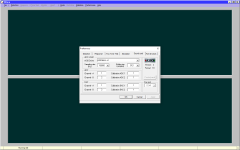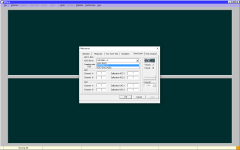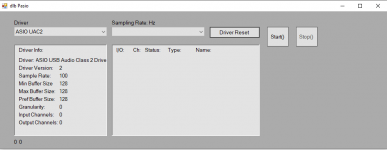Hi David,
At which stage you get the error msg? No errors while selecting an ASIO driver under preferences?
Regarding he error msg itself: it says "ASI" instead of "ASIO". Very strange, as I couldn't find a typo in the source listings. It looks like the memory and/or the ini file has been corrupted. Sometimes a fresh ini file will help (by deleting the old one).
That "-5" means it couldn't acquire information on the driver.
>"I get this with the EMU and ARTA as well" That suggests something is wrong with the driver. Maybe re-installing it will cure these issues. What about other programs (if you have them) using the EMU card?
Otherwise try this ASIO latency check: CEntrance -> Latency Test Utility and see if this program have issues with the driver.
Cheers,
E.
At which stage you get the error msg? No errors while selecting an ASIO driver under preferences?
Regarding he error msg itself: it says "ASI" instead of "ASIO". Very strange, as I couldn't find a typo in the source listings. It looks like the memory and/or the ini file has been corrupted. Sometimes a fresh ini file will help (by deleting the old one).
That "-5" means it couldn't acquire information on the driver.
>"I get this with the EMU and ARTA as well" That suggests something is wrong with the driver. Maybe re-installing it will cure these issues. What about other programs (if you have them) using the EMU card?
Otherwise try this ASIO latency check: CEntrance -> Latency Test Utility and see if this program have issues with the driver.
Cheers,
E.
Okay Edmond I found problem. That's a serious problem. It's much worse with .net apps. A big latency between mouse moves and GDI response.
Did you report this to Microsoft Dev team?
Cheers,
Of course I did, and (of course) they did nothing about it. Most likely, they don't care, as most people don't opt for "Show window content while dragging" and if they do, they don't see that something is wrong or think it's "normal". 😡
Cheers,
E.
Hi Edmond,
The error is right after starting DiAna. No error while selecting drivers.
The driver is the EMU original that came with the 0204. It never did work well in win10. Better in XP but that blew up long ago and was replace with win10.
I did here the tone when DiAna was recording
I try the driver with ARTA and get back to you.
Cheers,
The error is right after starting DiAna. No error while selecting drivers.
The driver is the EMU original that came with the 0204. It never did work well in win10. Better in XP but that blew up long ago and was replace with win10.
I did here the tone when DiAna was recording
I try the driver with ARTA and get back to you.
Cheers,
Hi Edmond,The EMU driver works in ARTA.
I deleted the ini file. DiAna works now but I still get the error message at startup.
I deleted the ini file. DiAna works now but I still get the error message at startup.
Of course I did, and (of course) they did nothing about it. Most likely, they don't care, as most people don't opt for "Show window content while dragging" and if they do, they don't see that something is wrong or think it's "normal". 😡
Cheers,
E.
I'm not surprised. I don't think MS cares about win32 exe's. If it were the new technologies then they would look into it.
Are you on the Windows Insider Program? Here you have access to the win developers on a forum for win10 and win10 related technologies along with other outside developers. It's free to sign up.
Hi David,Hi Edmond,
The error is right after starting DiAna. No error while selecting drivers.
Right after the start-up, the register is scanned to find all ASIO drivers. It is here where (probably) something went terribly wrong, most likely a buffer overflow, as the error msg was 'mutilated'. Driver names, for example, may not longer than 32 characters (according to Steinberg). In real life, sometimes they are longer! For that reason I've increased the buffer size to 128 bytes.
But at this moment, it's hard to say if it has anything to do with a name buffer overflow. Next time, please have a look at 'Preferences!-> 'Sound card' and inspect driver name, sampling rate, buffer size, ASIO version (=2) and format (most of the time = 18). Note that I have not implemented all possible formats, only the most common: ASIOSTInt16LSB (#16), ASIOSTInt24LSB (#17), ASIOSTInt32LSB (#18) and ASIOSTInt24MSB (#1).
There is no driver especially written for W10?The driver is the EMU original that came with the 0204. It never did work well in win10. Better in XP but that blew up long ago and was replace with win10.
That's weird. So, despite the error msg, it did at least something: DAC ouput, but no ADC input.I did here the tone when DiAna was recording
Good luck.I try the driver with ARTA and get back to you.
Cheers,
Cheers,
E.
Sure, it looks like that. On the other hand, Win32 API's are still the backbone of Windows, i.e. certainly not obsolete.I'm not surprised. I don't think MS cares about win32 exe's. If it were the new technologies then they would look into it.
Yes, Yes and Yes. But it's not of any help to me, as they talking about new technologies, like Cortana, Windows Store, etc. Nowadays, MS can't make money with developing perfect Win32 API's.Are you on the Windows Insider Program? Here you have access to the win developers on a forum for win10 and win10 related technologies along with other outside developers. It's free to sign up.

Cheers E.
@Edmond
I deleted the ini file and started again. The error message at start still occurs and here are some screen shots for the rest including the only ASIO drivers on my machine.
I deleted the ini file and started again. The error message at start still occurs and here are some screen shots for the rest including the only ASIO drivers on my machine.
Attachments
Last edited:
And what happens when you select the E-MU driver from that list?
edit: Did you get that error msg at the very start of DiAna, or after selecting the E_MU driver, or after starting a recording?
edit: Did you get that error msg at the very start of DiAna, or after selecting the E_MU driver, or after starting a recording?
Last edited:
Hi Edmond,
The error message is before selecting a driver. It's there at start up.
Nothing happens after selecting a driver. That part works fine.
I updated the previous post with my register entries. Only two driver are there and DiAna is showing three. This area of the registry is were we are supposed to be getting our ASIO driver list from and CLSID.
https://www.google.ca/url?sa=t&rct=...entries.html&usg=AOvVaw3qJud6URVNAjdCIg2Vjtgu
Having three drivers listed in DiAna suggests DiAna is getting the info from some other area of the registry.
The error message is before selecting a driver. It's there at start up.
Nothing happens after selecting a driver. That part works fine.
I updated the previous post with my register entries. Only two driver are there and DiAna is showing three. This area of the registry is were we are supposed to be getting our ASIO driver list from and CLSID.
https://www.google.ca/url?sa=t&rct=...entries.html&usg=AOvVaw3qJud6URVNAjdCIg2Vjtgu
Having three drivers listed in DiAna suggests DiAna is getting the info from some other area of the registry.
Last edited:
Hi David,
Now we are getting somewhere, but also something weird is going on:
>"Having three drivers listed in DiAna suggests DiAna is getting the info from some other area of the registry."
The only entry where DiAna looks for driver names is: HKEY_LOCAL_MACHINE -> Software -> ASIO (in C: RegOpenKey( HKEY_LOCAL_MACHINE, "software\\asio", &key ); ), in the same way as prescribed in the ASIO SDK.
So the big question is: where does the 3rd driver name, ASIO UAC2, come from?
What about a search on ASIO UAC2 in the registry? Maybe the entry or location of this fake driver will gives us a clue.
Cheers, E.
Now we are getting somewhere, but also something weird is going on:
>"Having three drivers listed in DiAna suggests DiAna is getting the info from some other area of the registry."
The only entry where DiAna looks for driver names is: HKEY_LOCAL_MACHINE -> Software -> ASIO (in C: RegOpenKey( HKEY_LOCAL_MACHINE, "software\\asio", &key ); ), in the same way as prescribed in the ASIO SDK.
So the big question is: where does the 3rd driver name, ASIO UAC2, come from?
What about a search on ASIO UAC2 in the registry? Maybe the entry or location of this fake driver will gives us a clue.
Cheers, E.
Hi Edmond,
On top of my head, isn't that just the ASIO USB audio class 2 driver?
Cheers,
Mogens
On top of my head, isn't that just the ASIO USB audio class 2 driver?
Cheers,
Mogens
Hi mck,
Yes, I think so. But the question is why does it appear on the audio preference menu of DiAna and doesn't appear in the registry at HKEY_LOCAL_MACHINE -> Software -> ASIO ?
Is it a quirk of Windows 10?
Cheers, E.
Yes, I think so. But the question is why does it appear on the audio preference menu of DiAna and doesn't appear in the registry at HKEY_LOCAL_MACHINE -> Software -> ASIO ?
Is it a quirk of Windows 10?
Cheers, E.
Hi Edmond,
Again, just a guess. But, I would imagine it's the author of the driver that didn't add it to registry at HKEY_LOCAL_MACHINE -> Software -> ASIO. Old driver?
Btw. Not sure if it's win10 quirk. Rarely use windows these days.
Cheers,
Mogens
Again, just a guess. But, I would imagine it's the author of the driver that didn't add it to registry at HKEY_LOCAL_MACHINE -> Software -> ASIO. Old driver?
Btw. Not sure if it's win10 quirk. Rarely use windows these days.
Cheers,
Mogens
To all,
Is there anybody who has an RTX6001 working together with DiAna without issues?
Please, let me know, as I'm wondering whether perhaps DiAna has some trouble with ASIO-USB devices anyhow. I have to admit that till now I've not yet tested the program with such a device.
Cheers, E.
Is there anybody who has an RTX6001 working together with DiAna without issues?
Please, let me know, as I'm wondering whether perhaps DiAna has some trouble with ASIO-USB devices anyhow. I have to admit that till now I've not yet tested the program with such a device.
Cheers, E.
Edmond you are right it is the ASIO UAC2 diver. I removed the driverabout a year ago. I was using it to test the ASIO software I was working on at the time. It does exist in other areas of the registry. I manually removed it from the said directory.
This machine has gone through a number of win10 updates since then. So it is possible win10 is messing with DiAna if MS changed something in the handling API.
A search found WOW6432NODE/ASIO but this is an uninstall entry.
Driver info is spread all through the registry. never just in one place.
Might there be a hidden entry in the registry? Can't imagine why.
I could send you a copy of my registry but it is frickin huge.
Cheers,
This machine has gone through a number of win10 updates since then. So it is possible win10 is messing with DiAna if MS changed something in the handling API.
A search found WOW6432NODE/ASIO but this is an uninstall entry.
Driver info is spread all through the registry. never just in one place.
Might there be a hidden entry in the registry? Can't imagine why.
I could send you a copy of my registry but it is frickin huge.
Cheers,
Oh by the way it also shows up in ARTA.
It also shows up in a test app I coded.
It also shows up in a test app I coded.
Attachments
Last edited:
Hi David,
>" I could send you a copy of my registry but it is frickin huge."
I don't think that makes much sense. I would have a look at it, but you can do it as well and even better. After saving the registry, what about deleting all keys with "ASIO UAC2"?
>So it is possible win10 is messing with DiAna if MS changed something in the handling API." I wouldn't be surprised.
Cheers, E.
>" I could send you a copy of my registry but it is frickin huge."
I don't think that makes much sense. I would have a look at it, but you can do it as well and even better. After saving the registry, what about deleting all keys with "ASIO UAC2"?
>So it is possible win10 is messing with DiAna if MS changed something in the handling API." I wouldn't be surprised.
Cheers, E.
Is that the only one you have found so far?I found an entry at
WOW6432Node/CLSID
WOW6432Node/ASIO/ASIO USB Audio Class 2 Driver
- Home
- Design & Build
- Equipment & Tools
- DiAna, a software Distortion Analyzer



